Ijraset Journal For Research in Applied Science and Engineering Technology
- Home / Ijraset
- On This Page
- Abstract
- Introduction
- Conclusion
- References
- Copyright
Literature Review of Wavelet-Based Image Filtering Methods
Authors: M. Nguessotat Moindop, B.O. Yenke
DOI Link: https://doi.org/10.22214/ijraset.2024.63203
Certificate: View Certificate
Abstract
Noise is a random signal that corrupts the quality of an image. For many decades, eliminating it or reducing its intensity in the image has been a major concern for many scientists. To this end, several studies on image processing (with the aim of eliminating or reducing the intensity of noise) have been carried out. Although a multitude of filtering methods emerged from these studies, numerous works have shown the effectiveness of the wavelet transform in image filtering. Thus, several wavelet-based methods (for image filtering purposes) have been illustrated in the literature. Some methods involve performing wavelet decomposition followed by thresholding and other methods involve combining wavelet decomposition with various filtering methods. This combination can have two or more methods. After filtering, the effectiveness of the filter can be evaluated. It is measured in terms of qualitative and/or quantitative parameters. Indeed, a filtering method is said to be efficient when the PSNR parameter (parameter most used in the literature) obtained has a minimum value of 30dB. This article presents a literature review of wavelet-based image filtering methods. Emphasis is placed on works presenting a better PSNR value (wavelet type, combination carried out, mother wavelet, decomposition number). In the end, this article gives a panoramic view of the choices of tools to use by a reader who would like to get involved in image filtering.
Introduction
I. INTRODUCTION
According to D. Lingrand [1], image processing refers to all the techniques used to improve an image and extract information deemed relevant. It can be applied in several fields such as robotics, remote sensing, security and medical imaging. Among the techniques used in image processing, we have filtering, compression, restoration and segmentation. Image filtering, which is our center of interest, is an essential step in the image analysis process. In fact, it makes it possible to eliminate or reduce the noise (or spurious information) present in an image. This facilitates its interpretation and therefore decision-making, which is a very important step whatever the field of study. In order to find a method to improve the quality of an image, and thus facilitate rapid and efficient decision-making, this work reviews various image filtering methods. The study summarized in this article highlights the different image filtering methods based on wavelets. Indeed, numerous studies on image processing have proven that the wavelet transform makes it possible to easily determine singularities in the image. Among other things, it makes it possible to effectively filter images while preserving both their structures and their textures [2], [3], [4]. Furthermore, in the context of image denoising, using a wavelet-based method can achieve better results thanks to properties such as multi-resolution and multi-scale [5]. Additionally, wavelet-based methods have shown better results compared to other filtering methods in denoising ultrasound images of the heart [6]. This article aims to provide the reader with a deeper and more comprehensive knowledge of the wavelet transform applied to image filtering. The rest of the document is structured as follows: Section I emphasizes the concepts and types of noise encountered in images; Section II deals with the wavelet transform; Section III presents the different metrics for evaluating the performance of filtering methods; Section IV illustrates the state of the art of different wavelet-based image filtering methods and Section V presents the discussion. The work ends with a conclusion and future directions.
II. NOISE IN IMAGES
A. Definition of Noise
Noise is defined differently from one author to another. The work of [7]–[11] allows us to define it as being a signal appearing randomly in the image and altering the quality of the latter.
B. Sources of Noise
Due to its random nature, noise can have various origins. The acquisition phase [12] and the effect of environmental conditions during the image transmission process [8] can be the cause of noise in the images.
C. Types of Noise
The removal of noise in the image has been the subject of several studies from which it appears that to eliminate noise in an image, it is necessary to identify the type of noise in order to apply the algorithm or method to the image. deemed more effective; that is to say whose performance is quite satisfactory. For this purpose, several types of noise could be identified. The table below summarizes the different types of noise encountered in the literature.
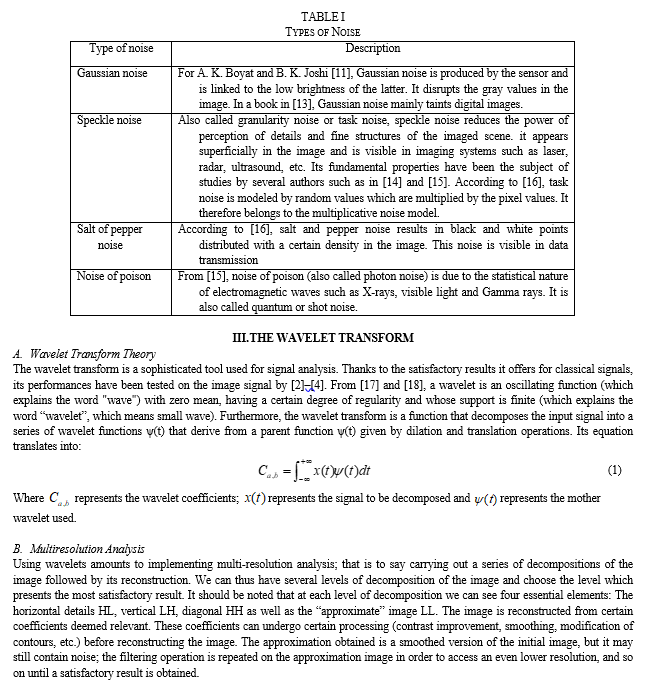
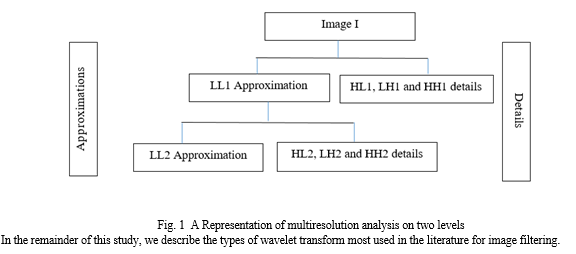
C. Types of Wavelet transform
- The Discrete Wavelet Transform: It is a mathematical tool as mentioned by [19] effective and useful to decompose the signal [8]. It is widely used in various fields of image processing [20]. It allows the signal to be analyzed in both the time and frequency domains. The wavelet transform implements the principle of multiresolution which consists of breaking the image into four sub-bands. This decomposition thus makes it possible to treat each sub-band individually. When the different sub-bands have been analyzed, a reconstruction of the image must be carried out. The performance of the discrete wavelet transform appreciated by many authors has led to its use in the context of image denoising.
- The dual-density dual-tree discrete wavelet transform: According to [21], the double-density dual-tree wavelet transform is a transform that combines the characteristics of the dual-tree discrete wavelet transform and that of the dual-tree discrete wavelet transform. density. Its filter bank structure is composed of two iterated over-sampled filter banks operating in parallel. In each filter bank, the synthesis filters are the time-reversed versions of the analysis filters [22]. After one level of decomposition, we obtain nine (more detailed) sub-bands. This is why, thanks to this transform, we can obtain images of excellent quality [23]. However, complicated wavelet transforms are not always the best performing (compared to real discrete wavelet transforms); and it is not always true that more redundancy equals higher image denoising performance [22].
- Non-decimated wavelet transform: The non-decimated wavelet transform is a shift-invariant transform which unlike the classical wavelet transform eliminates undersampling and oversampling. It is therefore more suitable for identifying stationary and non-stationary behaviors in signals [24]. With this transform, the number of pixels involved in the calculation of a coefficient increases more slowly and thus the relationship between frequency and spatial information more precise. Ideally, this means that noise removal is only done where it actually appears without affecting neighboring pixels [25]. However, it has been underused in the literature; this is why an article in [24] presented its advantages. Although very little used in the literature compared to the classic discrete wavelet transform, the performance of the non-decimated wavelet transform has been evaluated by some authors with regard to image denoising.
- The complex double-tree wavelet transform: According to [26], the complex double-tree wavelet transform was first introduced by Kingsbury in 1998. Unlike the classical form of the wavelet transform (DWT-Discrete Wavelet Transform), the transform complex wavelet is almost invariant and requires relatively few calculations. Its use requires two separate filter banks to calculate the complex values: a filter bank for the real part and another filter bank for the imaginary part. In the 2D case, the complex wavelet transform requires six wavelet filters to extract information in six analysis directions: ±15°, ±45° and ±75° [27].
In practice, in addition to the type of wavelet transform, it is necessary to define the mother wavelet to use. For this purpose, there are numerous mother wavelets used in image filtering. The following lines summarize the mother wavelets most used in image filtering.
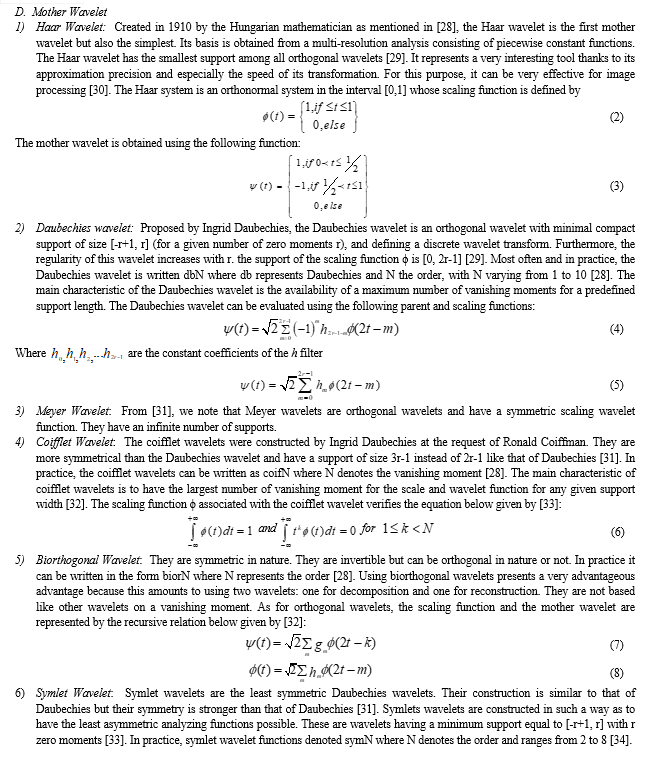
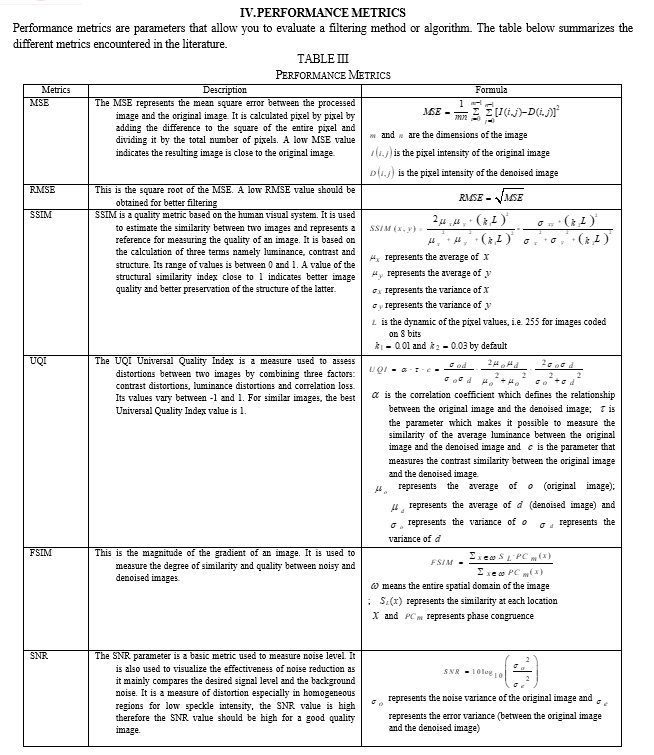

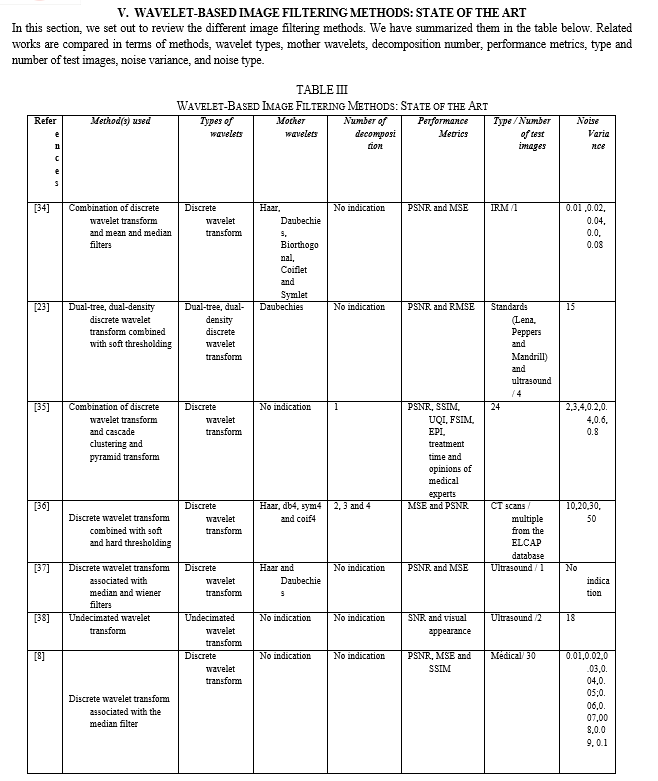
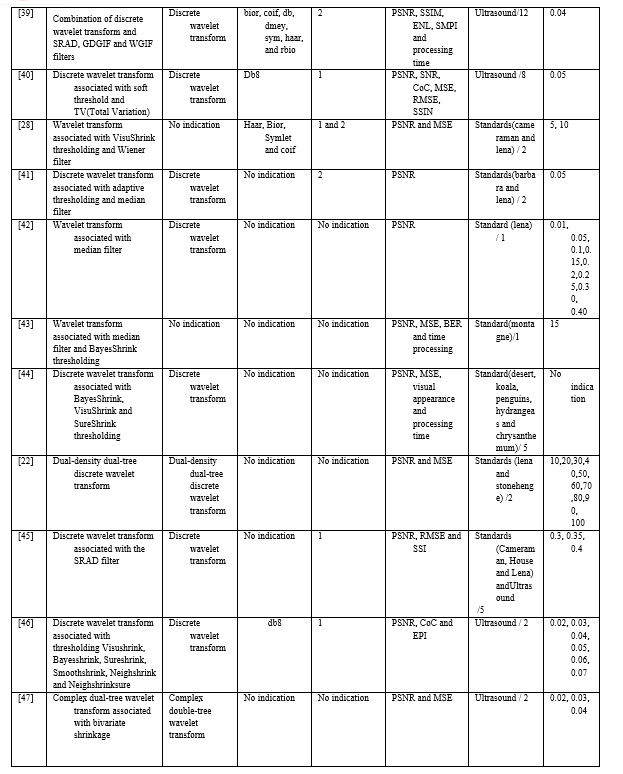
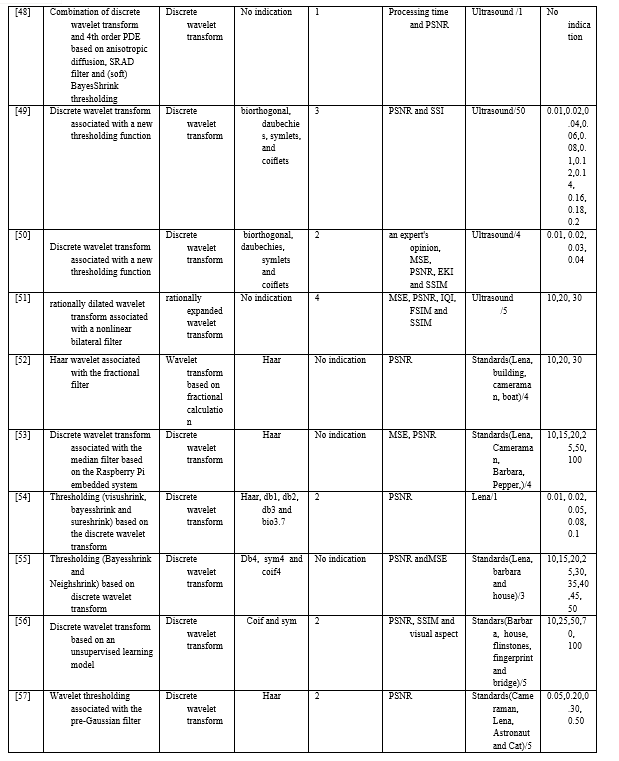
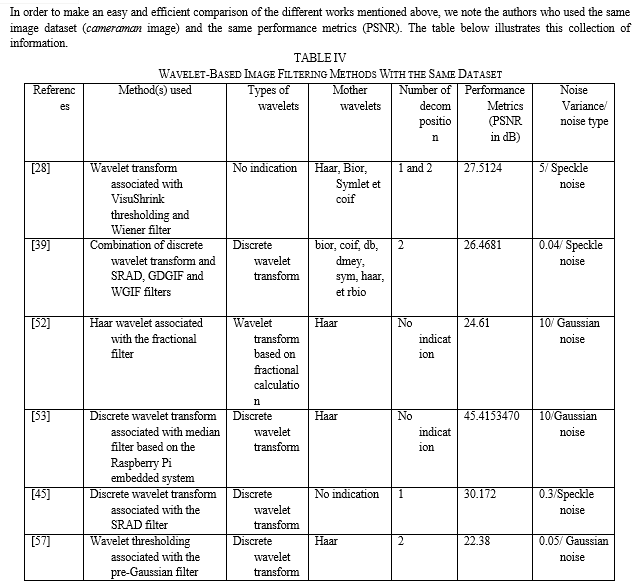
VI. DISCUSSION
In the study on wavelet-based ultrasound image filtering methods, the authors agree on one point: the wavelet transform is a tool that can considerably improve the quality of a filter. It effectively reduces speckle noise. In addition, to further multiply the performance of the wavelet transform, the authors performed various combinations. They combined the wavelet transform with other filtering methods. Combinations of metrics were also carried out in order to effectively evaluate the performance of the filter developed. From the point of view of the wavelet type, the discrete wavelet transform is the one that has been used the most by the authors, this could be due to the fact that it is the simplest and easiest wavelet transform to implement, but also because there is a strong literature on this subject. Furthermore, some authors such as article in [22] and in [23] implemented another type of wavelet transform named dual-density dual-tree discrete wavelet transform. This choice is probably due to the fact that this transform combines the characteristics of two wavelet transforms: the dual-tree discrete wavelet transform and the dual-density discrete wavelet transform.
In addition, [47] used the complex double-tree transform for its ability to offer decomposition in six possible directions. Also, although little illustrated in the literature, the non-decimated wavelet transform was implemented by [38]. We can justify this choice by the fact that this transform has an advantage over the others: it removes noise only in the places where it is found.
From the point of view of the mother wavelet used, [28], [34], [36], [37], [39], [49], [50] tested several mother wavelets in order to detect the most effective one. Other authors like [23], [40] and [46] directly implemented the mother wavelet based on its efficiency mentioned in previous works. All these authors have chosen the Daubechies wavelet in general. As for the particularity, the db4 and db8 wavelets are the most used. This is due to the fact that they are the basis of most mother wavelets (coifflets, symlets) but also because they produce better results. As for the decomposition number, the work presented allows us to note that this number can range from 1 to 4. However, no justification for the choice of the decomposition number was mentioned by the authors. In our opinion, this choice is influenced by several parameters including the characteristics of the image and the type of wavelet transform used.
Regarding performance metrics, we noted several that we were able to group into two groups: qualitative metrics and quantitative metrics. While the authors [8], [39], [43], [22], [23], [28], [34], [36], [37], [40]–[42], [45]–[49] and [51] only use quantitative metrics of other authors like [12], [38], [44] and [50] used both qualitative and quantitative metrics. We share the order of thought of [12,38,44,50] because qualitative metrics allow on the one hand to appreciate the visual quality of the image. Indeed, the final goal of filtering being to make the image easy to analyze, it is however essential that it be visually free of noise. Knowing that the filtering process can affect the visual quality of the final image. On the other hand, this allows us to have the opinion of experts in the field because it is the final target of this study. In order to improve the visual quality of the image, some authors such as [35] after filtering proposed a method for improving the visual quality of the image. Note that filtering does not always mean that a perfect image will be obtained because this process can somewhat alter the visual quality of the image, most often a blurring effect is observed. To this end, when engaging in a filtering process, an image improvement step should be considered in order to perfect the filtering.
A. Discussion Summary
In order to objectively assess the different filtering methods encountered in the literature, we noted the works whose authors validated the results using the same image dataset and the same performance metrics. To this end, we noted that most of the work was tested using standard images such as: Lena, cameraman, barbara, house, boat and peppers. Additionally, the metric common to all is PSNR. Considering the value of this parameter as a gauge for assessing the quality of the proposed filtering method, we note that the method proposed by [53] is the best because it presents the highest value with a PSNR=45.4153470 dB. This value is obtained by using the cameraman image corrupted with Gaussian noise with a noise level of . We therefore retain that the use of the discrete wavelet transform (with the Haar wavelet as the mother wavelet) associated with the median filter is the best combination for developing a filtering method. Considering that there are more sophisticated types of wavelets and mother wavelets than the discrete wavelet transform and the Haar wavelet, could their use not further improve the value of the PSNR parameter? Also, there are other filters more efficient than the median filter with which said wavelet transforms could be associated. Since it has been proven that the combination or association of wavelet transform with other filtering methods is the best formula to use in order to develop an effective filter.
Conclusion
In this paper, several existing works on filtering methods were compared using the quantitative PSNR metric. It appears that the best method for effective filtering is the combination of the discrete wavelet transform and the median filter. In general, it appears that a wavelet-based filtering method produces excellent results when the wavelet transform is combined with other filtering methods. This combination makes it possible to pool the advantages of the methods used but also to minimize their disadvantages. However, the result depends on certain parameters: the type of transform used, the mother wavelet, the number of decomposition and the type of combination carried out. Thus, it is essential to choose these different parameters judiciously and effectively in order to perfect the filter developed. Ultimately, the comparisons carried out in this work on the different image filtering methods based on wavelets allow the reader to decide on the choice of the effective method to adopt when investing in image filtering. It would be interesting to set up an intelligent system that would help the reader in their decision-making.
References
[1] D. Lingrand, “Cours de traitement d’images”, courses notes, Nice SophiaAntipolis University, 2004 [2] Sameer Khedkar, Kalyani Akant and Milind M. Khanapurkar, “Image denoising using wavelet transform”, IJRET Journal, vol-5, Issue 4, 2016 [3] P. V. V. Kishore, K. L. Mallika, M. V. D. Prasad and K. L. Narayana, “Denoising Ultrasound Medical Images with Selective Fusion in Wavelet Domain”, Journal of Procedia Computer Science, vol 58, issue 1, 2015, pp129 2015 [4] A. Fathi and A. R. Naghsh-Nilchi, “Ef?cient image denoising method based on a new adaptive wavelet packet thresholding function”, Journal of IEEE Transactions on image processing, vol. 21, n°9., Sept 2012, pp3981-3990 [5] S. Inderjeet and C. Lal, “Image Denoising Techniques: A review”, IJERT Journal, vol.2, issue.4, 2013 [6] K. Pallavi and M. Deepa, “A review on echocardiographic image speckle reduction filters”, Biomedical Research, vol.29, Issue 12, 2018 [7] K. Bnou, S. Raghay and A. Hakim, “A wavelet denoising approach based on unsupervised learning model”, EURASIP Journal on Advances in Signal Processing, Vol 2020, Issue 1, 2020 [8] L. M. Satapathy, P. Das, A. Shatapathy and A. K. Patel, “Bio-Medical Image Denoising using Wavelet Transform”, International Journal of Recent Technology and Engineering (IJRTE), ISSN: 2277-3878, Volume-8, Issue-1, May 2019 [9] S. Bharati, T. Z. Khan, P. Podder and N. Q. Hung, “A comparative analysis of image denoising problem: noise models, denoising filters and applications”, In book: Cognitive Internet Medical Things for Smart Healthcare, Pubisher: Springer, 2020, pp49-66, doi: 10.1007/978-3-030-55833-8_3 [10] A. M. Salami, D. M. Salih and A. F. Fadhil, “Thermal image features and noise effects analysis”, 7th International Engineering Conference Research &Innovation amid Global Pandemic (IEC2021) Erbil, Iraq, pp43-47, 2021 [11] A. K. Boyat and B. K. Joshi, “A review paper: noise models in digital image processing”, Signal & Image Processing: An International Journal (SIPIJ), Vol.6, No.2, 2015 [12] P. Singh, R. Mukundan and Rex de Ryke, “Enhanced steerable pyramid transformation for medical ultrasound image despeckling”, IEEE 20th International Workshop on Multimedia Signal Processing (MMSP), Vancouver, BC, Canada, pp1-6, August 2018 [13] C. Boncelet, Handbook of Image and Video Processing (Communications, Networking and Multimedia), Academic Press, Inc., Orlando, FL, USA, 2005 [14] P. Singh and R.S. Pandey, “A comparative study to noise models and image restauration techniques”, International Journal of Computer Applications, Volume 149 – No.1, 2016 [15] Priyanka Kamboj and Versha Rani, “A Brief study of various noise models and filtering techniques”, Journal of Global Research in Computer Science, Vol. 4, no. 4, 2013 [16] G Dougherty, Digital images processing for medical applications, Cambridge University Press, New York, USA, 2009 [17] B. R. Bakshi, “Muliscale Analysis and Modeling using Wavelets”, Journal of Chemometrics, vol 13, n°1, 1999, p415–434. [18] M. Barlaud, “Wavelets in Image communications”, Sciences Elsevier, 1994, 270pages [19] A. M. Abdulazeez, D. Q. Zeebaree, D. A. Zebari, G. M. Zebari and I. M. Najim Adeen “The Applications of Discrete Wavelet Transform in Image Processing: A Review”, Journal of Soft Computing and Data Mining, vol.1, N°. 2, 2020, pp31-43 [20] H. Choi and J. Jeong, “Speckle noise reduction for ultrasound images by using speckle reducing anisotropic diffusion and Bayes threshold”, J Xray Sci Technol, 27(5), pp885-898, 2019 [21] D. Bhonsle and S. Dewanga, “A comparative study of dual-tree complex wavelet transform and double density complex wavelet transform for image denoising using wavelet-domain”, International Journal of Scientific and Research Publications, vol. 2, Issue. 7, 2012 [22] B. Shoban Babu, S. Swarnalatha, V. Govindaraj, “Denoising technique using double density dual tree dwt for medical images”, Journal of Pharmaceutical Negative Results, vol. 13, Issue. 3, 2022 [23] C. Vimala and P. Aruna Priya, “Double Density Dual Tree Discrete Wavelet Transform implementation for Degraded Image Enhancement”, Journal of Physics Conference Series, Volume 1000 (1), Janvier 2018 [24] G.O.N. Brassarote, E.M. Souza and J.F.G. Monico, “Non-decimated Wavelet Transform for a Shift-invariant Analysis”, Tendências em Matematica Aplicada e Computacional, Vol. 19, N. 1, 2018, pp 93-110 [25] A. Gyaourova, C. Kamath and I. K. Fodor, “Undecimated wavelet transforms for image de-noising”, Lawrence Livermore National Laboratory, Livermore, California, Technical report, UCRL-ID-150931, November 19, 2002. [26] H. Vermaak, P. Nsengiyumva and N. Luwes, “Using the Dual-Tree Complex Wavelet Transform for Improved Fabric Defect Detection”, Journal of Sensors, Volume 2016, 8 pages [27] A. Othmani, “Identification automatisée des espèces d’arbres dans des scans lasers 3D réalisés en forêt”, Thesis, Paris-Est Créteil Val de Marne University, France, May 2014 [28] P. Koranga, G. Singh, D. Verma, S. Chaube, A. Kumar, S.Pant, “A New Proposed Hybrid Method for Image Denoising based on Wavelet Transform”, Fronteiras: Journal of Social, Technological and Environmental Science, Vol.6, n°2, 2017, pp.21-28 [29] J. Bigot. “Analyse par ondelettes”, courses notes, Master 2 professionnel IMAT, University of Paul Sabatier- Toulouse III, France, 2009 [30] J.F.Rasolomanana and P.A Randriamitantsoa, “Ondelettes de Haar et ses transformées”, MADA-ETI, vol. 2, 2015 [31] A. Dogra, B. Goyal, S. Agrawal, “Performance comparison of different wavelet families based on bone vessel fusion”, Asian Journal of Pharmaceutics, vol. 10 (4), 2016 [32] Çaglar Uyulan and Türker Tekin Ergüze, “Comparison of wavelet families for mental task Classification”, The Journal of Neurobehavioral Sciences, Vol. 3, Issue. 2, 2016 [33] A. Lanani, “Construction d’une ondelette fractionnaire adaptative appliquée au traitement de signal et au traitement d’image”, Doctoral thesis, Faculty of Technology, Batna 2- Mostefa Ben Boulaid University, 2024 [34] F. Joharah and S. Nisha, “Noise removal based on discrete wavelet transform and filters”, International Journal of Innovative Research in Science, Engineering and Technology, Vol. 6, Issue 6, June 2017 [35] P. Singh, “Feature enhanced speckle reduction in ultrasound images”, Thesis, University of Canterbury (New Zealand), August 2019 [36] L. Gabralla, H. Mahersia and M. Zaroug, “Denoising CT images using wavelet transform”, International Journal of Advanced Computer Science and Application (IJACSA), vol. 6, No 5, 2015 [37] N. Attlas and S. Gupta, “Wavelet Based Techniques for Speckle Noise Reduction in Ultrasound Images”, Journal of Engineering Research and Applications, ISSN: 2248-9622, Vol. 4, Issue 2 (Version 1), February 2014, pp.508-513 [38] A. Pižurica, W. Philips, I. Lemahieu and M. Acheroy, “A versatile wavelet domain noise filtration technique for medical imaging”, IEEE Transactions on Medical Imaging, Vol. 22, No. 3, 2003, pp. 323-331 [39] H. Choi and J. Jeong, “Despeckling algorithm for removing speckle noise from ultrasound images”, Symmetry, 12(6), 2020 [40] A. Banazier, Abrahim, A. M. Zeinab, A. Y. Inas, Z. Nourhan, and M. K. Yasser, “Hybrid Total Variation and wavelet thresholding speckle reduction for medical ultrasound imaging”, Journal of Medical Imaging and Health Informatics, Vol. 2, 2012, pp1–11 [41] V. Dhanushree and M. G. srinivasa, “Image denoising using median filter and dwt adaptive wavelet threshold”, IOSR Journal of VLSI and Signal Processing (IOSR-JVSP), Volume 5, Issue 3, 2015, pp50-57 [42] P. Rakheja and R. Vig, “Image denoising using combination of median filtering and wavelet transform”, International Journal of Computer Applications, Volume 141 – No.9, May 2016 [43] L. Passrija, A. Singh Virk and M. Kaur, “Performance Evaluation of Image Enhancement Techniques in Spatial and Wavelet Domains”, International Journal of Computers & Technology, ISSN: 2277-3061, Volume 3, No. 1, AUG 2012 [44] V. Gupta, R. Mahle and R. S. Shriwas, “Image denoising using wavelet transform method”, Tenth International Conference on Wireless and Optical Communications Networks (WOCN), Bhopal, India, 2013, pp1-4 [45] P. L. Joseph Raj, K. Kalimuthu, Sabitha Gauni and C. T. Manimegalai, “Extended speckle reduction anisotropic diffusion filter to despeckle ultrasound images”, Intelligent Automation & Soft Computing, vol.34, no.2, 2022 [46] R.Vanithamani and G. Umamaheswari, “Despeckling of Medical Ultrasound Images”, International Journal of Engineering and Technology (IJET), Vol. 5, No. 6, 2014 [47] R. Mavudila Kongo, M. Cherkaoui, L. Masmoudi and N. Hassanain, “A combined Dual-Tree Complex Wavelet (DT-CWT) and bivariate shrinkage for ultrasound medical images despeckling”, International Journal of Computer Applications, Volume 49, No.14, July 2012 [48] K. Karthikeyan and C. Chandrasekar, “Speckle noise reduction of medical ultrasound images using Bayesshrink wavelet threshold”, International Journal of Computer Applications, Volume 22, No.9, May 2011 [49] S. K. Randhawa, R. K. Sunkaria and E. Puthooran, “Despeckling of ultrasound images using novel adaptive wavelet thresholding function”, Multidimensional Systems and Signal Processing, Vol.30, 2018, pp1545-1561 [50] A. K. Bedi and R. K. Sunkaria, “Ultrasound speckle reduction using adaptive wavelet thresholding”, Multidimensional Systems and Signal Processing, 33(4), 2021, pp1-26 [51] D. Gupta, R.S. Anand and Barjeev Tyagi, “Enhancement of medical ultrasound images using non-linear filtering based on rational-dilation wavelet transform”, Proceedings of the World Congress on Engineering and Computer Science (WCECS), San Francisco, USA, Vol 1, 2012 [52] L. Abderrahim, M. Salama, D. Abdelbaki, “Novel design of a fractional wavelet and its application to image denoising”, Bulletin of Electrical Engineering and Informatics, Vol. 9, No. 1, February 2020, pp. 129~140 [53] R. Sabah, R. Ngadiran, D. A. Hammood, “Image denoising using wavelet and median filter based on raspberry Pi”, Jurnal Informatika, Vol. 15., No. 2, May 2021, pp. 91-102 [54] K. Kumar, L. Varshney, A. Ambikapathy, K. Malik, K. Vanshika and A. Vats, “Image denoising by wavelet based thresholding method”, 2nd International Conference on Advance Computing and Innovative Technologies in Engineering (ICACITE), Greater Noida, India, 2022, pp.63-73 [55] G. Kaur, M. Garg, S. Gupta and R. Gupta, “Denoising of images using Thresholding Based on Wavelet Transform Technique”, IOP Conf. Series: Materials Science and Engineering, 1022(1), 2021 [56] K. Bnou, S. Raghay and A. Hakim, “A wavelet denoising approach based on unsupervised learning model”, EURASIP Journal on Advances in Signal Processing, 2020(1), 2020, pp.1-26 [57] Nitin and S.B. Gupta, “A Hybrid Image denoising method based on discrete wavelet transformation with pre-gaussian filtering”, Indian Journal of Science and Technology, 15(43), 2022, pp.2317-2324
Copyright
Copyright © 2024 M. Nguessotat Moindop, B.O. Yenke. This is an open access article distributed under the Creative Commons Attribution License, which permits unrestricted use, distribution, and reproduction in any medium, provided the original work is properly cited.

Download Paper
Paper Id : IJRASET63203
Publish Date : 2024-06-09
ISSN : 2321-9653
Publisher Name : IJRASET
DOI Link : Click Here
 Submit Paper Online
Submit Paper Online

